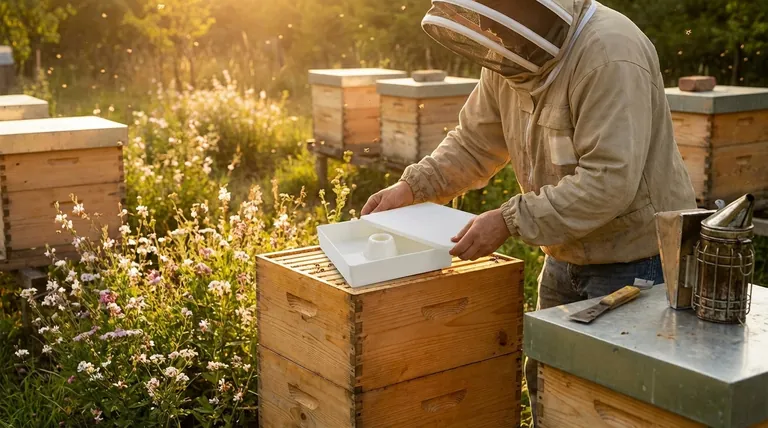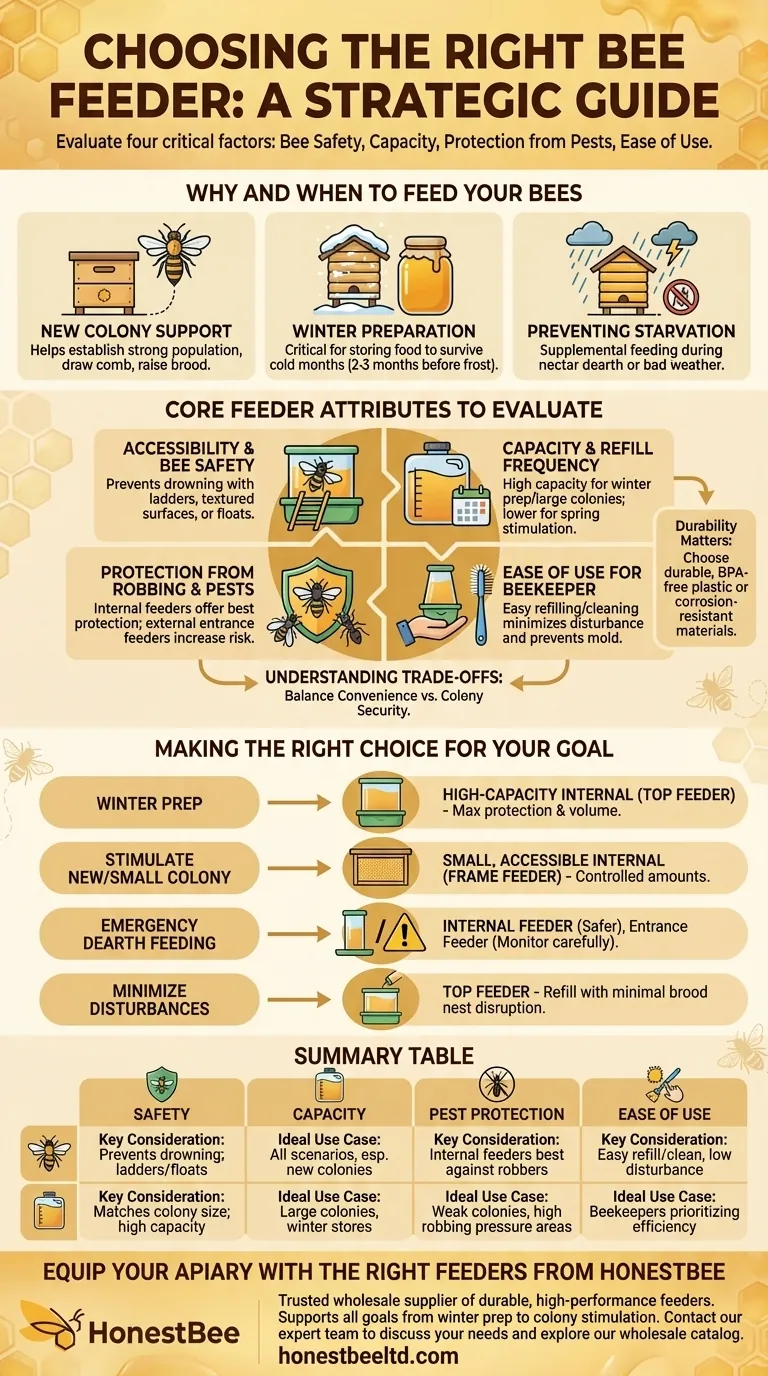To choose the right bee feeder, a beekeeper must evaluate four critical factors: bee safety, capacity, protection from pests, and ease of use for the beekeeper. Different feeder designs present unique advantages and drawbacks in these areas. Your choice will depend on your colony's specific needs, the time of year, and your management style.
The most effective bee feeder is not a single product, but a strategic tool chosen for a specific purpose. Your goal—whether it's establishing a new colony, preparing for winter, or preventing starvation—should be the primary driver of your decision.

Why and When to Feed Your Bees
Understanding the purpose of feeding is the first step in selecting the right equipment. Feeding is not a constant activity but a targeted intervention for specific situations.
Supporting a New Colony
Newly established colonies are working hard to draw out comb, raise brood, and gather resources. Providing a steady supply of sugar syrup gives them the energy they need to build their home quickly and establish a strong population before the main nectar flow begins.
Preparing for Winter
Feeding is critical during the fall, typically two to three months before the first frost. This allows the bees to store enough food to survive the cold winter months when foraging is impossible. A lack of sufficient winter stores is a primary cause of colony loss.
Preventing Starvation
During a nectar dearth—a period when few flowers are blooming—or in prolonged bad weather, a colony can quickly consume its stores. Supplemental feeding during these times can prevent the colony from starving.
Core Feeder Attributes to Evaluate
Every feeder design represents a series of trade-offs. Evaluating them against these key attributes will clarify which feeder best suits your needs.
Accessibility and Bee Safety
The feeder's primary job is to provide food without harming the bees. Drowning is a significant risk with liquid feed. Look for designs that include ladders, textured surfaces, or floating mechanisms that allow bees to access the syrup safely without falling in.
Capacity and Refill Frequency
Feeder capacity determines how often you must interact with the hive. High-capacity feeders are ideal for large, established colonies or for winter preparation, as they minimize disturbances. Smaller-capacity feeders are suitable for nucleus colonies or for stimulative spring feeding.
Ease of Use for the Beekeeper
Consider how easily the feeder can be refilled and cleaned. Some designs allow you to refill them without opening the hive, which reduces stress on both the bees and the beekeeper. Cleanliness is also vital to prevent the growth of mold in the syrup.
Protection from Robbing and Pests
The smell of sugar syrup can attract bees from other hives (robbing) as well as ants and wasps. Internal feeders, such as top feeders placed inside the hive body, offer the best protection. External entrance feeders are easy to monitor but significantly increase the risk of robbing.
Understanding the Trade-offs
No single feeder is perfect for all situations. Beekeepers often own several types to use for different purposes throughout the year. Your choice involves balancing convenience against colony security.
The Risk of Convenience
Feeders that are easiest to refill, like entrance feeders, are often the most exposed. They place the food source at the front door of the hive, creating a "help yourself" sign for robbers and pests, which can decimate a weak colony.
The Effort of Security
Internal feeders, such as top feeders or frame feeders, offer superior protection. They keep the syrup inside the hive, making it much harder for outsiders to access. However, they almost always require you to open the hive to check levels and refill, causing a greater disturbance to the colony.
Durability and Material
The material of the feeder impacts its longevity and safety. Look for feeders made from durable, BPA-free plastic or corrosion-resistant materials. A cheap, poorly made feeder can break down, leak inside the hive, and create a disastrous mess.
Making the Right Choice for Your Goal
Select your feeder based on a clear objective. This ensures the tool you choose directly supports your colony's success.
- If your primary focus is winter preparation: Choose a high-capacity internal feeder, like a top feeder, to provide a large volume of syrup with maximum protection from robbers.
- If your primary focus is stimulating a new or small colony: Use a smaller, easily accessible internal feeder, like a one-quart frame feeder, to provide controlled amounts of food without overwhelming them.
- If your primary focus is emergency feeding during a dearth: An entrance feeder can work for a strong colony if monitored carefully, but an internal feeder is always a safer choice to prevent robbing.
- If your primary focus is minimizing hive disturbances: Select a top feeder that can be refilled with minimal disruption to the brood nest below.
Ultimately, choosing a feeder is an exercise in understanding your colony's needs and anticipating the associated risks.
Summary Table:
| Feeder Attribute | Key Consideration | Ideal Use Case |
|---|---|---|
| Bee Safety | Prevents drowning; look for ladders or floats. | All feeding scenarios, especially new colonies. |
| Capacity | Matches colony size; high capacity for winter prep. | Large colonies, fall feeding for winter stores. |
| Pest Protection | Internal feeders offer the best protection from robbers. | Weak colonies, areas with high robbing pressure. |
| Ease of Use | Easy to refill and clean without excessive hive disturbance. | Beekeepers prioritizing efficiency and minimal stress. |
Equip your apiary with the right feeders from HONESTBEE.
As a trusted wholesale supplier for commercial apiaries and beekeeping equipment distributors, we provide durable, high-performance feeders designed for safety and efficiency. Our range supports your specific goals, from winter preparation with high-capacity top feeders to stimulating new colonies with secure frame feeders.
Let us help you make the strategic choice for your colonies. Contact our expert team today to discuss your needs and explore our wholesale catalog.
Visual Guide

Related Products
- HONESTBEE Professional Hive Top Bee Feeder Feeding Solution
- Professional Hive Top Bee Feeder for Beekeeping
- Professional Hive Front Entrance Bee Feeder
- HONESTBEE Entrance Bee Feeder Professional Hive Nutrition Solution for Beekeeping
- Professional In-Hive Bee Feeder HONESTBEE Frame for Beekeeping
People Also Ask
- What should be done with feeders and equipment after feeding bees? Essential Steps for Apiary Health
- What is a top feeder for bees? Maximize Colony Health with Efficient Feeding
- What is the best way to top feed bees? A Safe, High-Volume Feeding Solution for Your Apiary
- Do I need an inner cover with a hive top feeder? Optimize Your Hive Setup for Healthy Bees
- Why is a top feeder essential for bees? Ensure Colony Health and Efficiency



















